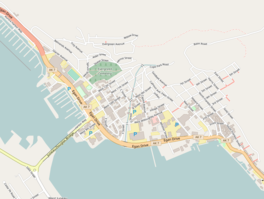| Mendenhall Glacier | |
|---|---|
| Sít | |
 Mendenhall Glacier and frozen Mendenhall Lake | |
| Type | Mountain glacier |
| Location | Coast Range, Juneau, Alaska, U.S. |
| Coordinates | 58°29′45″N 134°31′56″W / 58.49583°N 134.53222°W[1] |
| Terminus | Proglacial lake |
| Status | Retreating |
 | |


Mendenhall Glacier (in Tlingit language “Sít”) is a glacier about 13.6 miles (21.9 km) long located in Mendenhall Valley, about 12 miles (19 km) from downtown Juneau in the southeast area of the U.S. state of Alaska.[2] The glacier and surrounding landscape is protected as part of the 5,815 acres (2,353 ha) Mendenhall Glacier Recreation Area, a federally designated unit of the Tongass National Forest.[3]
The Juneau Icefield Research Program has monitored the outlet glaciers of the Juneau Icefield since 1942, including Mendenhall Glacier. The glacier has also retreated 1.75 miles (2.82 km) since 1929, when Mendenhall Lake was created, and over 2.5 miles (4.0 km) since 1500. The end of the glacier currently has a negative glacier mass balance and will continue to retreat in the foreseeable future.[4]
Given that average yearly temperatures are currently increasing, and the outlook is for this trend to continue, it is actually possible that the glacier might experience a period of stabilization or slight advance during its retreating march. This is because increasing amounts of warm, moist air will be carried up to the head of the icefield, where colder ambient temperatures will cause it to precipitate as snow. The increased amount of snow will feed the icefield, possibly enough to offset the continually increasing melting experienced at the glacier's terminus. However, this interesting phenomenon will fade away if temperatures continue to climb, since the head of the glacier will no longer have cold enough ambient temperatures to cause snow to precipitate.
- ^ "Mendenhall Glacier". Geographic Names Information System. United States Geological Survey, United States Department of the Interior. Retrieved July 14, 2012.
- ^ School of Arts & Sciences. "Mendenhall Glacier Facts" (PDF). University of Alaska Southeast. Retrieved August 7, 2015.
- ^ "Forest Service". fs.fed.us.
- ^ Alaska Looks for Answers in Glacier’s Summer Flood Surges July 22, 2013 New York Times

